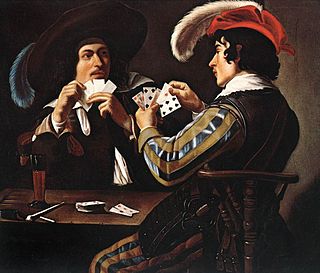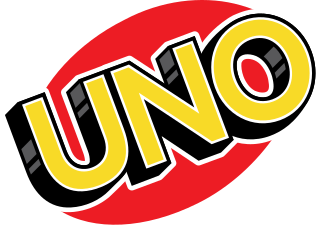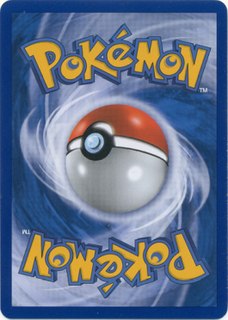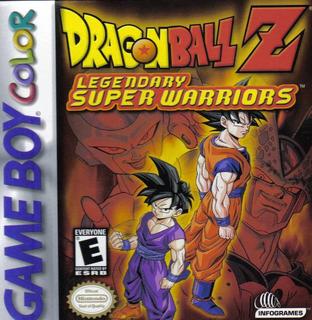Gameplay
There are four types of cards (Warrior, Shen Gong Wu, Master, and Villain) and four elements (Earth, Fire, Wind, and Water) which are associated with the four Xiaolin monks and the color of the non-Villain cards. During the game, each player has a deck, a hand, a Warrior Training Area, a Vault, and a discard pile which cards will move between according to rules. There is also a Showdown Arena that is used by both players when they wish to start a Xiaolin Showdown. In addition to winning by being the first to win four Shen Gong Wu in a Showdown, it is possible to lose by running out of cards in one's deck and then being required to draw
Card types
The type of card dictates how it can be played. Each card has a skill number in a circle and a power number in a hexagon. The lower the skill number, the easier it is to bring the card into play. The higher the power number, the more powerful the card will be when used in a Xiaolin Showdown for a Shen Gong Wu.
Warrior
Each turn, a player may play one Warrior card to his Training Area. Such cards are played face up and upside down, so that Warrior icon on the card is right side up. The skill and power numbers of a Warrior card in the Training Area do not matter. However, the number of cards in the Training Area determines one's skill level, which is also important. During a showdown, a Warrior card may be used as a Boost card, and any special ability the card has applies only then.
These cards are named after various martial arts moves that are used in the series as well as a number of additional moves with similar names, but which have not been used so far. This includes cards for the signature moves for the Xiaolin monks as both Xiaolin apprentices and Wudai warriors in the second and third season of the series. The Xiaolin apprentice move cards are "Rare" cards and the Wudai Warrior move cards are "Premium" cards.
Shen Gong Wu
Each turn, a player may play one Shen Gong Wu card. Such cards may either be played directly to one's Vault or be made the subject of a Xiaolin Showdown. A Shen Gong Wu card may be played directly to one's Vault only if you have a number of Warriors equal to or more than the skill number of the Shen Gong Wu. This does not count as victory in a Xiaolin Showdown, but does enable the player to tap the card in future Showdowns. If a player has no Shen Gong Wu in his hand, or does not wish to play one that is hand, he may choose to flip over the top card in his deck. If the card is a Shen Gong Wu, then there will be a Showdown for it. If it is not a Shen Gong Wu, it goes to the discard pile. During a showdown, a Shen Gong Wu card in a player's hand may be used as a Boost card. Shen Gong Wu that are in a player's vault may also be used, and any special ability that the Shen Gong Wu has applies only when the card is tapped.
Not all of the Shen Gong Wu that have been featured on the show have cards in the game and some of the Shen Gong Wu in the game had not been featured on the show as of the game's launch. The game debuted during the show's third season and the promotional material for the game indicated that they would be used in future episodes, thus making purchasing the game a way for fans of the series to learn about the Shen Gong Wu before they were used on the show. Some of the Shen Gong Wu cards in the game are labeled with a second descriptor such as Animal, Armor, Clothing, Weapon, Jewel, or Trinket. Such descriptors have no effect on gameplay under the current version of the rules, but may have some effect either on tournament rules or with a future expansion set.
Master
Master cards are treated as if they were Warrior cards, except for three differences:
- The special ability that the card has applies when the card is in the training area, but not when used as a Boost card.
- Because of this reversal of when the special ability is used, the warrior icon and the power and skill numbers are placed upside down from where they are found on a Warrior card and the card is played right side up in the Training Area instead of upside down.
- You must have a number of Warrior cards of the same color already in your Training Area to play a Master card in your training area.
Villain
Villain cards are used in place of Boost cards during a Xiaolin Showdown, and at no other time during the game. Villain cards are distinctive in that they have Gray color and they have four separate power numbers. The power number that is used depends upon the color of the Shen Gong Wu that is the object of the Showdown. Villain cards are only effective when played by the defending player, and if more than one Villain Card is played, they do not work together.
Elements
There are four elements, each of which is associated with a monk, and with the color scheme of the card.
- Earth, Yellow, Clay
- Fire, Red, Kimiko
- Water, Dark Blue, Omi
- Wind, Light Blue, Raimundo
Xiaolin Showdown
A Xiaolin Showdown begins when an attacking player chooses to put a Shen Gong Wu in the Showdown Arena.
Each player may tap , similar to the system used in Magic: The Gathering, Shen Gong Wu that are in his Vault up to the point where the sum of the skill numbers of the tapped cards equals the number of Warriors in his Training Area. At least one of the Warriors in his training area must be the same color as the Shen Gong Wu in order for the Shen Gong Wu to be tapped. Any special ability that the Shen Gong Wu has can only be applied when the card is tapped. Only Shen Gong Wu cards can be tapped in this game.
After both players have decided whether to tap any Shen Gong Wu, each player may choose to play one card face down from his hand or from his deck. If the card played has a skill number that exceeds the number of Warriors in the player's Training Area, it has no effect. If the card is anything other than a Villain card, it is a Boost card. A Boost card adds its Power to the Power of the Shen Gong Wu that have been tapped to give the Power number of the player, but only if the player has a Warrior card in his Training Area that is the same color. If a Boost card has a special ability that applies during a Showdown it is also applied.
A Villain card played by the player who started the showdown has no effect. A Villain card played by the defending player has a Power number for that color Shen Gong Wu, and the attacking player must defeat both the defender and the Villain to win the Showdown. If a player uses a special ability that works upon winning a showdown, he must also beat any Villains in play for the ability to work.
Sometimes a special ability will allow a player to Press a card. If a player Presses a card, he may play a card from the deck as a second card that will act as a Boost or Villain card.
Ties in Showdowns are won first by Villains and then by the defending player. If the attacking player wins, the Shen Gong Wu goes into his Vault as an untapped card, and he has achieved one of the four victories needed to win the game. If he does not win, the Shen Gong Wu goes into his discard pile. Any Boost or Villain cards used during the Showdown go into that player's discard pile. Any Shen Gong Wu that were tapped remain tapped until either the start of that player's next turn or untapped by a special ability.

A card game is any game using playing cards as the primary device with which the game is played, be they traditional or game-specific.

Magic: The Gathering is a collectible and digital collectible card game created by Richard Garfield. Released in 1993 by Wizards of the Coast, Magic was the first trading card game and has approximately twenty million players as of 2015, and over twenty billion Magic cards produced in the period from 2008 to 2016, during which time it grew in popularity.

Uno is an American shedding-type card game that is played with a specially printed deck. The game's general principles put it into the Crazy Eights family of card games, and it is similar to the traditional European game Mau-Mau.
Xiaolin Showdown is an American animated television series that aired on Kids' WB and was created by Christy Hui. Set in a world where martial arts battles and Eastern magic are commonplace, the series follows four young Xiaolin warriors in training who battle the Heylin forces of evil. They do this by protecting Shen Gong Wu from villains that would use them to conquer the world. Typical episodes revolve around a specific Shen Gong Wu being revealed which results in both sides racing to find it. Episodes usually reach a head when one good and one evil character must challenge each other to a magical duel called a Xiaolin Showdown for possession of the artifact.

The Pokémon Trading Card Game, abbreviated to PTCG or Pokémon TCG, is a collectible card game, based on Nintendo's Pokémon franchise of video games and anime, first published in October 1996 by Media Factory in Japan. In the US, it was initially published by Wizards of the Coast; The Pokémon Company eventually took over publishing the card game in June 2003. In 2016, it was the year's top-selling toy in the strategic card game subclass. In 2017, it had an 82% share of Europe's strategic card game market. As of March 2019, the game has sold over 27.2 billion cards worldwide.

The Duel Masters Trading Card Game is a two-player or two vs. two team collectible card game (CCG) jointly developed by Wizards of the Coast and Takara Tomy. The card game is part of the Duel Masters franchise.

The 'Neopets TCG' is a collectible card game and a spin-off of the popular virtual pet website, Neopets. Launched in 2003, this game is produced by Wizards of the Coast, a large trading card company that produces a variety of other trading card games. Neopets is aimed at a slightly younger audience than other Wizards of the Coast offerings such as Magic: The Gathering. As with many other trading card games, there are two purposes of the trading cards; the first to collect the cards, and the second to play a devised game using the cards.
The Odyssey is a Magic: The Gathering expert-level block. It consists of a trio of expansion sets: Odyssey, Torment and Judgment.
Magic: The Gathering Limited Edition is the first Magic: The Gathering card set. It premiered in a limited release at Origins Game Fair in 1993, with a general release that August. The initial print run of 2.6 million cards sold out quickly, and a new printing run was released in October 1993. These two runs are known as Limited Edition Alpha and Limited Edition Beta, or just Alpha and Beta for short. Although Alpha and Beta are referred to as different sets by some, officially they are the same set; Wizards of the Coast had expected that people wouldn't necessarily be able to tell the two press runs apart. Beta fixed a number of misprints and errors on cards. The printer accidentally used different corner rounding dies for the second run, resulting in Alpha cards being noticeably distinct in shape and appearance from Beta cards and all subsequent cards. The Beta printing also included a revised rulebook with a number of clarifications, although creator Richard Garfield's short fiction "Worzel's Tale" was removed to make room. The print run of Beta is given as 7.3 million or 7.8 million depending on the source. Despite the set's print run being about three times as big as Alpha's, Beta sold out as quickly as its predecessor.

The Marvel Super Heroes Adventure Game is a role-playing game published by TSR, Inc. that uses the SAGA System and features characters published by Marvel Comics. It should not be confused with the earlier Marvel Super Heroes Game, also published by TSR, the later Marvel Universe Roleplaying Game, published by Marvel itself, or Marvel Heroic Roleplaying, published by Margaret Weis Productions.

Nertz (US) or Racing Demon (UK) is a fast-paced, real-time, multiplayer card game involving multiple decks of playing cards. It is often described as a combination of the card games Speed and Solitaire.

Dragon Ball Z: Legendary Super Warriors is a turn-based fighting game released for the Game Boy Color. It is played with the use of in-game cards for attacks, techniques and support items. The game's story takes place from the start of Dragon Ball Z, the Saiyan Saga, and runs until the end of the Buu Saga. The game also includes two extra stories involving Future Trunks's timeline. The game boasts a large array of characters for a Game Boy Color game, featuring all of the Ginyu Force, Super Saiyan forms of all characters that reach it, as well as the fusion characters Vegito and Gotenks.

Xiaolin Showdown is an action-adventure video game based on the Kids WB/CW4Kids cartoon of the same name. It was released on November 14, 2006. Players are able to play as the Xiaolin Apprentices, and one of the game objectives is to get the Shen Gong Wu. It is possible that new Shen Gong Wu were made specifically for this video game. The Shen Gong Wu require the use of "Chi Energy" from the player.
Gundam War: Mobile Suit Gundam the Card Game also known simply as Gundam War is an out-of-print collectible card game based on the Gundam anime series produced by Bandai. Players can simulate battles in the anime series. The game is designed for 2 players, though there may be different fan-created multiplayer rules. This game is sometimes confused with the Gundam M.S. War Trading Card Game, since both are published by Bandai and are based on the Gundam series.
Ravnica is a Magic: The Gathering block that consists of three expert-level expansion sets: Ravnica: City of Guilds, Guildpact, and Dissension. Following in the tradition of other Magic blocks, Ravnica takes place in a plane of the multiverse that was previously unexplored in the game's backstory. The world of Ravnica is an ecumenopolis, a vast city that covers the entire surface of its planet, and is home to a diverse assortment of sentient races. Much power in Ravnica is held by the ten "guilds", political factions that each represent a combination of two of Magic's five colors. The mythology of Ravnica is loosely derived from Slavic folklore, and the character names reflect this. This plane was revisited in the Return to Ravnica block, and the Guilds of Ravnica and Ravnica Allegiance sets.
Magic: The Gathering is a game with detailed and, at times, complex rules. Knowledge of the game's rules is necessary to play the game.
Weiß Schwarz is a Japanese collectible card game created by Bushiroad. The game is separated into Weiß-side and Schwarz-side. "Weiß" and "Schwarz" are German language for white and black, respectively.
Xiaolin Chronicles is an American-French animated/CG television series presented as a continuation of the Warner Bros. Animation's series, Xiaolin Showdown. The series premiered on August 26, 2013, with three back-to-back episodes serving as a preview. The full series premiered on September 14, 2013. It was produced by ActionFliks Media Corporation in collaboration with the French studio Genao Productions. Due to copyright some elements of the original show had to be changed.









